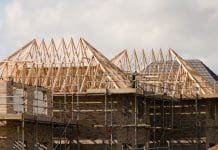Construction output growth faded to “near-stagnation” levels in January as residential building activity contracted, new orders declined and business activity growth fell to a four-month low
The latest Construction Purchasing Managers’ Index from the Chartered Institute of Procurement & Supply and analyst Markit shows the fall in housebuilding was accompanied by lacklustre growth in commercial and civil engineering activity.
Nevertheless, despite the subdued start to the year and uncertainty following the collapse of Carillion, confidence about future growth prospects improved, with many firms expecting an increase in new project wins later in the year.
Construction output
Housebuilding, which had been construction’s main driver, slipped into decline after 16 months of expansion, posting the worst showing since July 2016.
Commercial activity returned to growth, reversing a six-month period of decline, although the pace of expansion was only marginal.
Civil engineering activity also rose after declining towards the end of last year, although again the improvement was very modest.
The subdued growth in building activity saw job creation across construction hit an 18-month low in January. While some firms took on more staff anticipating project wins in the future, others cut jobs due to lower workloads.
New orders decreased for the first time in four months, with many businesses linking the fall to general political and economic uncertainty.
Cost pressures across the construction industry remained intense in January, despite softening slightly compared with December. Input cost inflation was drive by a variety of materials, including bricks, timber and copper.
Subcontractor use increased in January after 10 months of decline, showing the strongest rise since November 2016. As a result, subcontractor availability fell sharply.
“A contraction in housebuilding added to lacklustre commercial building and civil engineering markets, and reduced inflows of new work suggest overall activity could slip into decline in February,” said Sam Teague, economist at IHS Markit and the report’s author.
“Constructors’ optimism towards future growth prospects reached a seven-month high. Many forecasted that the soft patch in construction demand would be short-lived and new project wins would pick up throughout the year, though this will inevitably depend on how Brexit negotiations play out. Despite the upturn, optimism remains worryingly low by historical standards.”













